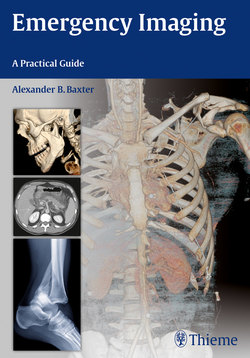Читать книгу Emergency Imaging - Alexander B. Baxter - Страница 98
На сайте Литреса книга снята с продажи.
Оглавление85
3 Head and Neck
◆Imaging and AnatomyImaging
Face CT (Noncontrast Helical)
Indications: Facial, orbital, or mandibular trauma.
Technique: 0.6-mm dataset with 1–2-mm axial, 2-mm sagittal, and 2-mm coronal reformations of head, face, and cervical spine. Oblique sagittal images, 1 mm, along the course of the optic nerve may be obtained for evaluation of orbital pathology. Images obtained from orbital roof to hyoid (unless obtained in conjunction with head and cervical spine CT).
Face CT (Helical + Contrast)
Indications: Orbital cellulitis, suspected facial abscess, mass.
Technique: 0.6-mm dataset with 1–2-mm axial, 2-mm sagittal, and 2-mm coronal reformations of head, face, and cervical spine. Oblique sagittal images, 1 mm, along the course of the optic nerve may be obtained for evaluation of orbital pathology. Images obtained from orbital roof to hyoid (unless obtained in conjunction with head and cervical spine CT).
Contrast: 60–100 mL at 1–2 mL/sec with 100-second delay.
Neck CT (Helical + Contrast)
Indications: Neck mass, abscess, adenopathy.
Technique: 0.6-mm dataset with 2–3-mm axial, 2-mm sagittal, and 2-mm coronal reformations of head, face, and cervical spine. Images obtained from orbital roof to thoracic inlet.
Contrast: 60–100 mL at 1–2 mL/sec with 100-second delay.
Neck CT Arteriogram
Indications: High-energy blunt trauma, suspected arterial dissection, penetrating injury.
Technique: 0.6-mm dataset with 2-mm axial, 2-mm sagittal, and 2-mm coronal
Temporal Bone Approach
Like the face and neck, the temporal bone is a complex structure, and a repeatable anatomic method is useful in order to avoid errors. One practical approach is to:
1. Address structures from outside to inside, beginning with the auricle and ending with the ossicles.
2. Evaluate the mastoid bone.
3.Address structures from insideto outside, beginning at thecerebellopontine angle, evaluatingthe internal auditory canal, cochlea,vestibule, and semicircular canalsand ending with the facial nerve. Thefacial nerve, carotid canal, and jugularbulb canals can be dehiscent, and theyshould be described if so, as theseanatomic variants can complicatesurgery if not detected preoperatively.
Outside to Inside
• Auricle
• External auditory canal
• Tympanic membrane
• Tympanic cavity (hypo-tympanum and epitympanum)
• Sinus tympani and pyramidal eminence
• Ossicles and scutum
Mastoid Bone
• Mastoid air cells• Mastoid antrum• Tegmen tympani
• Tegmen mastoideum
Inside to Outside
• Cerebellopontine angle and brainstem
• Internal auditory canal
• Cochlea, vestibule
• Semicircular canals
• Vestibular aqueduct
• Petrous bone mineralization
• Facial nerve
• Carotid canal
• Jugular bulb
